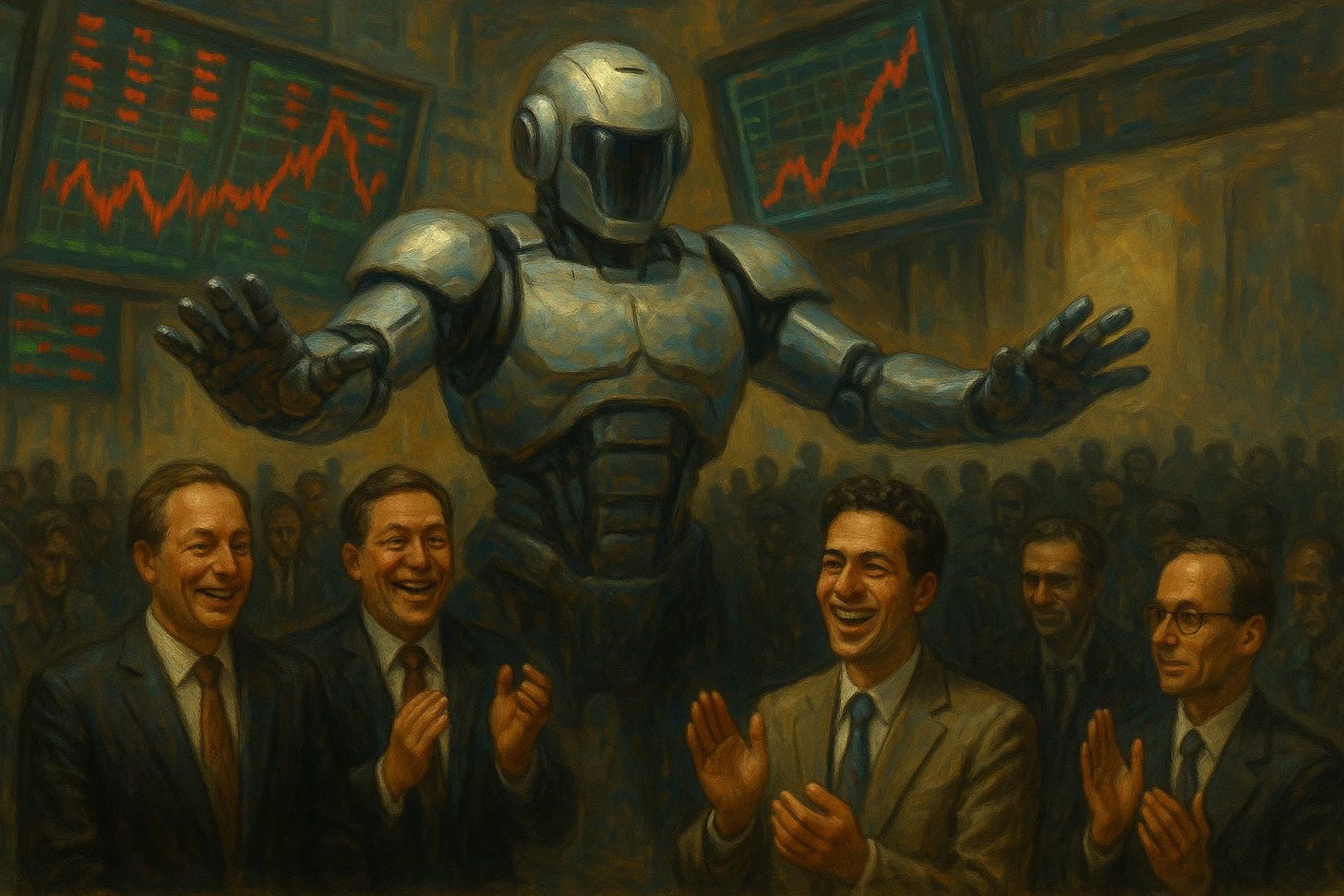America’s One-Engine Growth
Powell admits the economy runs on AI spending and the wealthy few.
If you want a single line that exposes how brittle this economy is, Powell gave it to you. We’re getting unusually large amounts of economic activity from the AI buildout.
Growth is coming from a narrow, cash-gushing slice of Silicon Valley while Main Street runs on fumes.
On September 17, Powell cut rates a quarter point and labeled it risk management. He also admitted growth is skewed toward higher-earning consumers and the job market is a low firing, low hiring environment.
That’s a tidy euphemism for stagnation.
Companies aren’t expanding. If layoffs tick up, there won’t be a lot of hiring going on. Inflation is still above target, with PCE at 2.7% and core at 2.9%. The Fed is toggling between an AI-fueled boom and a labor market losing altitude.
The market concentration is obscene. Seven firms control more than 30% of the S&P 500, and you know the roll call: Nvidia, Microsoft, Apple, Alphabet, Amazon, Meta, Tesla. Widen the lens to ten mega-caps and you’re near 39% of the entire index.
The Magnificent Seven delivered most of 2024’s returns and still set the tone. Calling an S&P index fund diversified in this regime is a joke. It’s a levered bet on ten boardrooms not changing their minds about the next data-center spree.
Is this a bubble? It doesn’t need to look like 1999 to end the same way for everyone else.
Yes, today’s titans are profitable and cash-rich, not Pets.com with a line of credit. The systemic risk simply changed flavor. If hyperscaler spending reverts to 2022 levels, one model puts the S&P’s multiple 15% to 20% lower.
That’s not apocalypse. It’s enough to yank the floorboards from a consumer economy living off paper wealth and high-end spending.
The more uncomfortable admission is on consumption. About 70% of U.S. GDP is consumer spending, and it’s tilted toward higher earners. That’s the K-shape. The top keeps buying travel, tech, and luxury, buoyed by market gains and higher yields. The bottom trades down and leans on credit.
Aggregate spending looks fine only because the top is doing the heavy lifting. Exactly. This is a one-engine plane.
The labor market that actually sustains demand is softening. August added 22,000 jobs while unemployment nudged to 4.3%. New grads, younger workers, and minorities are getting squeezed in a cooling market with vanishing churn.
Hires are low. Layoffs are low. Mobility is dead.
If layoffs finally hit, there’s no cushion of aggressive hiring to catch the fall. That’s why Powell cut. He isn’t rescuing growth. He’s buying time.
The Fed’s toolkit is gasoline and a hammer. A cut helps the struggling side of the K only indirectly, but it pours lighter fluid on the upper arm. Cheaper capital for hyperscalers. Higher asset prices for the already wealthy. The same move that props up a wobbly labor market also supercharges the concentration and inequality that make the system fragile.
That’s the Powell Dichotomy. Managing risk with one hand, feeding it with the other.
So, the near-term risk map looks like this:
A capex cliff. Big Tech dials back because ROI gets murky, supply tightens, or boards get fatigued. Headline investment sags. Goldman Sachs puts AI spend behind nearly all of the 7% year-over-year gain in corporate capex this spring. When so much GDP is riding on that spend, the mask slips.
Consumer fragility. If multiples deflate a bit or layoffs pick up, high-income spending cools and there’s no broad wage engine to replace it. The K turns into an L for the bottom half.
Policy impotence. The Fed can’t fix structural inequality with a policy rate. Cuts cushion jobs a little and fatten asset prices a lot. Hikes to chase PCE risk kneecapping a labor market already losing steam.
What about valuations? The research says the S&P’s forward ~21x isn’t 2000 fever, while tech north of ~35x is stretched but anchored in mega-profits. Fine. Calling that healthy because the cash flows are real misses the point.
When 30% to 35% of market cap sits in seven names, macro becomes micro. If those firms pause capex, earnings revisions follow, multiples compress, and the wealth effect flips. Fast.
AI widens the gap. Skill-biased tech change channels gains to high-skill workers and capital owners. The rest get displacement or slower wage growth. The data ties AI adoption to a rising top-1% share. That’s not a future of work panel. It’s the loop we’re living in. Inequality begets fragility. Fragility begets easier policy. Easier policy fattens assets. Assets concentrate further.
Rinse. Repeat. Until something breaks.
So where does that leave us? With an economy that is both remarkable and ridiculous. Remarkable because a handful of firms can summon a capital tide big enough to bend GDP. Ridiculous because a nation of 330 million is effectively hostage to ten companies’ capex plans and the spending habits of the top decile.
Powell’s candor is the tell. Growth is narrow. Demand is top-heavy. Labor stability is low-vol churn masking a loss of dynamism. He cut because he’s staring at the edge.
The unsettling ending is the honest one. This holds together right up until it doesn’t. The unusually large AI buildout becomes an unusually fragile economy the moment boards slow spend or the wealthy blink. When your safety net is capex guidance and luxury demand, you don’t have a safety net.



"This holds together right up until it doesn’t." That pretty much sums it up.